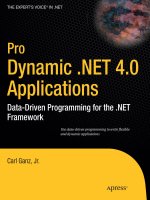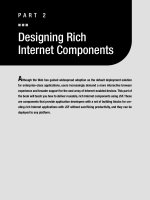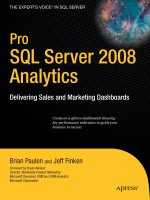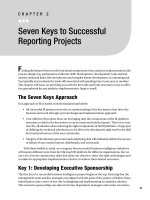Apress Pro JS Fand Ajax Building Rich Internet Compon - Introduction
Bạn đang xem bản rút gọn của tài liệu. Xem và tải ngay bản đầy đủ của tài liệu tại đây (129.14 KB, 3 trang )
Introduction
S
ince JavaServer Faces first arrived on the Internet technology stage as the new standard
for building Java-based Web applications, it has gained significant attention from the Java EE
Web development community. Many developers are excited that they can use the standard
JavaServer Faces HTML Basic RenderKit to create HTML-based Web applications, much as
they did in the past with other technologies, such as Apache Struts. However, this is only the
tip of the iceberg—the true power of JavaServer Faces lies in its extensible component model,
which allows you to go far beyond those humble HTML beginnings.
Based on the recent surge in demand for improved usability in Web applications, it is
understandable that the hottest topic at the moment is Rich Internet Applications (RIAs) and
how they offer distributed, server-based Web applications with a rich interface and the inter-
action capabilities of desktop applications. Although RIAs hold significant promise, they still
have issues with compatibility, portability, usability, and reusability. Many Web application
developers are struggling to keep up with new RIA frameworks, both open source and vendor
specific, as they appear on the market. What is needed is a standard way of defining an RIA
regardless of what RIA framework is being used.
The debate over the best way to develop and deploy RIAs will not end with this book, but
looking at the software industry today more and more developers are using the Web to deploy
their applications.
User interfaces for these Web applications are often built with technologies such as HTML,
CSS, JavaScript, and the DOM. These technologies were not developed with enterprise applica-
tions in mind, and with an increasing pressure from consumers to provide applications with
features not fully described or supported by these technologies, developers are looking for
alternative solutions or to extend the standards.
JSF does not just let you pick a single RIA technology such as Ajax, Mozilla XUL, Microsoft
HTC, Macromedia Flash, and so on; it lets you pick and combine any RIA technologies you
want and use them where they make the most sense. As with any technology, each RIA tech-
nology has its own advantages and disadvantages, but as a JSF component writer, you have
the opportunity to leverage the best functionality of each RIA technology to provide the appli-
cation developer with an extremely powerful RIA solution.
We have been very much involved in the development and the use of component-based
frameworks over the past five years, starting with Oracle’s own UI component framework,
ADF UIX, and lately with Oracle’s JSF component library, ADF Faces.
One day a very good friend asked us, “Why don’t you guys share some of your experience
and write a book about it?” What surprised us was that nobody had actually written a book
targeting developers who are interested in the same thing we are—how to develop reusable
standards-based JSF components for RIAs.
So, here we are, hoping that you will enjoy reading this book as much as we enjoyed
writing it.
xxi
5807fm.qxd 1/20/06 4:11 PM Page xxi
An Overview of This Book
Pro JSF and Ajax: Building Rich Internet Components is written to give you all the means to
provide your Web application developers with easy-to-use Rich Internet Components (RICs).
We decided early on that we would focus on establishing a clear blueprint that you as a devel-
oper could follow to be successful in your own JSF component development. We also decided
that we would not limit this book to “just” JSF components and that we would incorporate
everything you would need to know to be successful in developing, packaging, and deploying
your own RICs.
This book is not, and we would like to emphasize this, not an introductory level book
about JSF or about writing simple JSF components. Sure, this book introduces JSF and covers
the basics of writing JSF components, but if you have not acquainted yourself with JSF before
reading this book, we strongly encourage you to refer to a few excellent books that will introduce
you to JSF and give you the foundation needed to fully appreciate this book. We recommend JSF
in Action, by Kito D. Mann (Manning, 2005), which is an excellent and very complete book on
JSF, and Core JavaServer Faces, by David Geary and Cay Horstmann (Prentice, 2004). We are
also looking forward to seeing Java Server Faces: The Complete Reference, by Ed Burns and
Chris Schalk (McGraw-Hill Osborne, 2006), in stores.
Pro JSF and Ajax: Building Rich Internet Components contains ten chapters that focus
on writing JSF components. The book’s examples are fairly extensive, so we recommend you
download the example source code from the Apress Web site to give you a better overview of
the examples discussed (see the next section for more information). We assume that, as an
experienced Web developer and JSF developer, you can extrapolate the demonstrated topic
into your own environment; thus, we avoid cluttering the text and examples with information
that is of little use.
Chapter 1 gives a fast-paced and in-depth introduction to JSF, its component model, and
its lifecycle. You might have followed our recommendation to read up on JSF before buying
this book or you are already experienced working with JSF; either way, this chapter contains
crucial information about JSF and its lifecycle that is needed in order to successfully build
scalable and reusable JSF components.
Chapter 2 introduces the first JSF component: the date field component. We played with
the idea of having a component comprised of three input fields representing day, month, and
year, but this did not provide us with enough material to work with when moving forward
through the book. So instead, we focused this chapter on the essentials of building a com-
ponent, such as creating prototypes, managing resources, creating renderers, controlling
rendering of children, handling conversion, and figuring out what’s going on during post-
back. To be able to keep track of all the tasks associated with creating JSF components, this
chapter introduces the first steps in a JSF component design blueprint. The date field com-
ponent created in this chapter also introduces you to some new concepts and open source
projects when you improve its user interactivity in Chapter 7.
Chapter 3 introduces the second component: the deck component. The deck component
works like an accordion to show and hide information. This chapter discusses the JSF event
model and teaches you how to create new behavioral superclasses and new event types with
corresponding listener interfaces. By the time you finish Chapter 3, you will have enough
knowledge to start writing your own basic HTML components. During the course of this book,
you will be enhancing the deck and date field components, and you will be providing them
with extremely rich user interactivity that leverages RITs.
■
INTRODUCTIONxxii
5807fm.qxd 1/20/06 4:11 PM Page xxii
Chapter 4 introduces you to three RITs (Ajax, Mozilla XUL, and Microsoft HTC) and gives
you a high-level overview of these technologies. You will use these technologies in Chapters 6,
7, 8, and 9 to build rich interactivity into the date field and deck components. Of course, some
simple applications in this chapter will highlight the core features of each technology.
As promised, to be able to successfully build and package JSF components, and especially
RICs, you need a solution that can easily package resources, such as JavaScript libraries, CSS,
and images, into the same component library as your JSF infrastructure (renderers, behavioral
superclasses, and so on) and then serve them out from the same JAR. Chapter 5 introduces a
new open source project—Weblets—that makes resource file management and versioning as
easy for Web development as it already is for desktop-based Java development.
Chapters 6, 7, 8, and 9 address the need for a smoother and richer user experience when
users interact with your components in a JSF Web application. These four chapters leverage
everything you have learned so far and guide you through the gotchas of building Ajax-enabled
JSF components with HTML, XUL, and HTC. These chapters also introduce you to one estab-
lished and two new open source projects: the Dojo toolkit, Mabon, and D
2
.
Finally, Chapter 10 pulls it all together. In this chapter, you will learn how to leverage all of
the aforementioned techniques to provide your Web application developers (and users) with
enterprise-class JSF components that support multiple clients.
Obtaining This Book’s Source Code
All the examples in this book are freely available from the Source Code section of the Apress
Web site. Point your browser to , click the Source Code link, and find the
Pro JSF and Ajax: Building Rich Internet Components book. You can download the source as a
zip file from this book’s home page. All source code is organized by chapter. The zip file con-
tains an application workspace, built with Oracle JDeveloper 10.1.3, and contains one project
per chapter. Each project includes a WAR file that is ready to deploy to any J2EE 1.3–compliant
application server. For more information about Oracle JDeveloper, please refer to the Oracle
Web site at />Obtaining Updates for This Book
There are no errors in this book. Just kidding! Despite our best efforts to avoid any errors, you
may find one or two scattered throughout the book. We apologize for those potential errors
that may be present in the text or source code. A current errata list is available from this book’s
home page on the Apress Web site (), along with information about
how to notify us of any errors you may encounter.
Contacting Us
Any feedback, questions, and comments regarding this book’s content and source examples
are extremely appreciated. You can direct your questions and comments to
We will try to reply to your questions and comments as soon as we can, but please remember,
we (like you!) may not be able to respond immediately.
Lastly, we would like to thank you for buying this book! We hope you will find this book to
be a valuable source of information and inspiration and that you enjoy reading it.
■
INTRODUCTION
xxiii
5807fm.qxd 1/20/06 4:11 PM Page xxiii









